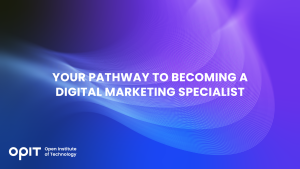

If you’re eyeing the digital marketing scene, know that every click tells a story, and every strategy can turn the tables for companies fighting for the online spotlight. Creativity meets metrics, and social media is a place to make connections that matter and spread the word about your brand or make it so that the word spreads on its own. Here is how to become a digital marketing specialist.
Understanding the Role of a Digital Marketing Specialist
Imagine being the person for everything online in a business. That’s more or less what a digital marketing specialist does.
They handle everything from making a website appear at the top of search results (thanks to SEO) to crafting the kind of content that makes people click, share, and buy. Specialists know what makes audiences tick on social media and keep up with the latest hashtag trends to figure out the best time to post. They don’t throw content out into the void and hope for the best—they analyze everything.
Which tweet has the most engagement? Did changing the call-to-action on that email campaign increase conversions? It’s all in a day’s work.
But what’s the big deal about all this, you might ask.
Being visible online is pretty much everything for a business these days. It matters little if it’s a local bakery or a multinational tech company. They all need to be online so potential customers can find them. Their digital marketing specialist uses a mix of creativity, analytics, and tech-savvy to boost brand awareness, rake in leads, and ultimately, drive sales. These specialists are the ones making sure a business is actively connecting with people and turning them into customers.
Essential Skills and Qualifications
To become a digital marketing specialist, you must have strong technical skills, creativity, and a fair bit of analytical prowess. Here’s a rundown:
- SEO/SEM reveals the alchemy of search engines that can make or break a brand’s online visibility. This skill helps you know the right keywords, the magic of backlinks, and the techniques of ranking higher.
- Content creation (blogs that tell a story, videos that captivate, or tweets that go viral) must resonate with your audience.
- Data analysis is great if you love numbers because dissecting website traffic, engagement rates, and conversion stats to understand what’s working (and what’s not) is a big part of the game.
- Social media expertise means knowing your TikToks from your Tweets. Each platform operates on a distinct system, and mastering these can help you connect with audiences effectively.
- PPC advertising is just as significant. Crafting the ads at the top of the search results requires a keen understanding of PPC strategies, especially if you’re aiming for a monetary balance.
As for the educational backdrop, while you don’t necessarily need a degree in digital marketing, having one in related fields like marketing, communications, or business can give you a solid foundation. That said, digital marketing values skills and real-world experience just as much, if not more.
Path to Becoming a Digital Marketing Specialist
Here’s a guide on how to be a digital marketing specialist:
1. Obtain a Relevant Degree
While you don’t need a degree in marketing to break into digital marketing, it undoubtedly helps. A bachelor’s in marketing, communications, or a related field lays a solid foundation. It introduces you to marketing principles, consumer behavior, and, increasingly, digital marketing basics. If college isn’t your path, there are still many success stories from self-taught specialists.
2. Get Hands-on Experience
There’s no substitute for getting directly involved in digital marketing. Internships are a great step, as they give you a peek into the industry’s workings and let you apply what you’ve learned. Or you can start your own project. Create a blog, manage social media for a family business, or run your own PPC campaigns to build a portfolio that showcases your skills.
3. Prioritize Continuous Learning
Digital marketing evolves fast, so you must keep up with the trends. Online courses and certifications can keep you up to date while also boosting your resume. Certifications like Google Ads, Facebook Blueprint, or SEMrush certifications also prove your skills and dedication to the craft. Each one is a step toward establishing your expertise.
4. Start Networking
Join digital marketing forums, attend webinars, and don’t be shy about reaching out to professionals you admire. The digital marketing community is surprisingly welcoming and a treasure trove of insights and opportunities.
5. Apply for Entry-Level Positions
With some education, a portfolio, and a few certifications under your belt, start applying for entry-level positions. Adjust your resume to highlight your digital marketing skills and projects, and don’t get discouraged by setbacks. Every interview, whether successful or not, is a point of learning.
OPIT’s Digital Marketing Education Programs
OPIT has a couple of solid programs up its sleeve for digital marketing—the BSc and MSc in Digital Business. They aren’t typical, dry lecture-based courses. These programs give you both the theory and practice necessary in digital marketing.
OPIT’s approach is unique in the way it blends theory with practice. You learn the latest trends, tools, and strategies currently being used in the industry. Plus, you’re not learning in a vacuum. OPIT connects you with industry experts, giving you a chance to pick the brains of people who have invaluable experience and skills. The programs offer first-hand insights, resources, and a network of professionals you’d be hard-pressed to find anywhere else.
Why Choose a Career as a Digital Marketing Specialist
For starters, every business out there, from the hole-in-the-wall coffee shop to giant corporations, is trying to make its mark online. That means there’s an enormous demand for people who can handle the digital world creatively and effectively.
This job also keeps you on your toes. One day, you might be cracking the code on a Google Ads campaign, and the next, you’re storytelling on Instagram or analyzing website traffic. It’s this mix of creativity, strategy, and analytics that makes the work diverse and, believe it or not, pretty exciting.
Become the Social Media Strategist You Were Meant to Be
The path to becoming a specialist is fairly varied, but two factors hold true: you need to keep on top of current trends, and you need hands-on experience. Fortunately, OPIT positions you on the right career path by providing just that. Check out OPIT’s bachelor’s and master’s programs in digital business and learn how to be a good digital marketing specialist first-hand.
Related posts

Source:
- Agenda Digitale, published on November 25th, 2025
In recent years, the word ” sustainability ” has become a firm fixture in the corporate lexicon. However, simply “doing no harm” is no longer enough: the climate crisis , social inequalities , and the erosion of natural resources require a change of pace. This is where the net-positive paradigm comes in , a model that isn’t content to simply reduce negative impacts, but aims to generate more social and environmental value than is consumed.
This isn’t about philanthropy, nor is it about reputational makeovers: net-positive is a strategic approach that intertwines economics, technology, and corporate culture. Within this framework, digitalization becomes an essential lever, capable of enabling regenerative models through circular platforms and exponential technologies.
Blockchain, AI, and IoT: The Technological Triad of Regeneration
Blockchain, Artificial Intelligence, and the Internet of Things represent the technological triad that makes this paradigm shift possible. Each addresses a critical point in regeneration.
Blockchain guarantees the traceability of material flows and product life cycles, allowing a regenerated dress or a bottle collected at sea to tell their story in a transparent and verifiable way.
Artificial Intelligence optimizes recovery and redistribution chains, predicting supply and demand, reducing waste and improving the efficiency of circular processes .
Finally, IoT enables real-time monitoring, from sensors installed at recycling plants to sharing mobility platforms, returning granular data for quick, informed decisions.
These integrated technologies allow us to move beyond linear vision and enable systems in which value is continuously regenerated.
New business models: from product-as-a-service to incentive tokens
Digital regeneration is n’t limited to the technological dimension; it’s redefining business models. More and more companies are adopting product-as-a-service approaches , transforming goods into services: from technical clothing rentals to pay-per-use for industrial machinery. This approach reduces resource consumption and encourages modular design, designed for reuse.
At the same time, circular marketplaces create ecosystems where materials, components, and products find new life. No longer waste, but input for other production processes. The logic of scarcity is overturned in an economy of regenerated abundance.
To complete the picture, incentive tokens — digital tools that reward virtuous behavior, from collecting plastic from the sea to reusing used clothing — activate global communities and catalyze private capital for regeneration.
Measuring Impact: Integrated Metrics for Net-Positiveness
One of the main obstacles to the widespread adoption of net-positive models is the difficulty of measuring their impact. Traditional profit-focused accounting systems are not enough. They need to be combined with integrated metrics that combine ESG and ROI, such as impact-weighted accounting or innovative indicators like lifetime carbon savings.
In this way, companies can validate the scalability of their models and attract investors who are increasingly attentive to financial returns that go hand in hand with social and environmental returns.
Case studies: RePlanet Energy, RIFO, and Ogyre
Concrete examples demonstrate how the combination of circular platforms and exponential technologies can generate real value. RePlanet Energy has defined its Massive Transformative Purpose as “Enabling Regeneration” and is now providing sustainable energy to Nigerian schools and hospitals, thanks in part to transparent blockchain-based supply chains and the active contribution of employees. RIFO, a Tuscan circular fashion brand, regenerates textile waste into new clothing, supporting local artisans and promoting workplace inclusion, with transparency in the production process as a distinctive feature and driver of loyalty. Ogyre incentivizes fishermen to collect plastic during their fishing trips; the recovered material is digitally tracked and transformed into new products, while the global community participates through tokens and environmental compensation programs.
These cases demonstrate how regeneration and profitability are not contradictory, but can actually feed off each other, strengthening the competitiveness of businesses.
From Net Zero to Net Positive: The Role of Massive Transformative Purpose
The crucial point lies in the distinction between sustainability and regeneration. The former aims for net zero, that is, reducing the impact until it is completely neutralized. The latter goes further, aiming for a net positive, capable of giving back more than it consumes.
This shift in perspective requires a strong Massive Transformative Purpose: an inspiring and shared goal that guides strategic choices, preventing technology from becoming a sterile end. Without this level of intentionality, even the most advanced tools risk turning into gadgets with no impact.
Regenerating business also means regenerating skills to train a new generation of professionals capable not only of using technologies but also of directing them towards regenerative business models. From this perspective, training becomes the first step in a transformation that is simultaneously cultural, economic, and social.
The Regenerative Future: Technology, Skills, and Shared Value
Digital regeneration is not an abstract concept, but a concrete practice already being tested by companies in Europe and around the world. It’s an opportunity for businesses to redefine their role, moving from mere economic operators to drivers of net-positive value for society and the environment.
The combination of blockchain, AI, and IoT with circular product-as-a-service models, marketplaces, and incentive tokens can enable scalable and sustainable regenerative ecosystems. The future of business isn’t just measured in terms of margins, but in the ability to leave the world better than we found it.

Source:
- Raconteur, published on November 06th, 2025
Many firms have conducted successful Artificial Intelligence (AI) pilot projects, but scaling them across departments and workflows remains a challenge. Inference costs, data silos, talent gaps and poor alignment with business strategy are just some of the issues that leave organisations trapped in pilot purgatory. This inability to scale successful experiments means AI’s potential for improving enterprise efficiency, decision-making and innovation isn’t fully realised. So what’s the solution?
Although it’s not a magic bullet, an AI operating model is really the foundation for scaling pilot projects up to enterprise-wide deployments. Essentially it’s a structured framework that defines how the organisation develops, deploys and governs AI. By bringing together infrastructure, data, people, and governance in a flexible and secure way, it ensures that AI delivers value at scale while remaining ethical and compliant.
“A successful AI proof-of-concept is like building a single race car that can go fast,” says Professor Yu Xiong, chair of business analytics at the UK-based Surrey Business School. “An efficient AI technology operations model, however, is the entire system – the processes, tools, and team structures – for continuously manufacturing, maintaining, and safely operating an entire fleet of cars.”
But while the importance of this framework is clear, how should enterprises establish and embed it?
“It begins with a clear strategy that defines objectives, desired outcomes, and measurable success criteria, such as model performance, bias detection, and regulatory compliance metrics,” says Professor Azadeh Haratiannezhadi, co-founder of generative AI company Taktify and professor of generative AI in cybersecurity at OPIT – the Open Institute of Technology.
Platforms, tools and MLOps pipelines that enable models to be deployed, monitored and scaled in a safe and efficient way are also essential in practical terms.
“Tools and infrastructure must also be selected with transparency, cost, and governance in mind,” says Efrain Ruh, continental chief technology officer for Europe at Digitate. “Crucially, organisations need to continuously monitor the evolving AI landscape and adapt their models to new capabilities and market offerings.”
An open approach
The most effective AI operating models are also founded on openness, interoperability and modularity. Open source platforms and tools provide greater control over data, deployment environments and costs, for example. These characteristics can help enterprises to avoid vendor lock-in, successfully align AI to business culture and values, and embed it safely into cross-department workflows.
“Modularity and platformisation…avoids building isolated ‘silos’ for each project,” explains professor Xiong. “Instead, it provides a shared, reusable ‘AI platform’ that integrates toolchains for data preparation, model training, deployment, monitoring, and retraining. This drastically improves efficiency and reduces the cost of redundant work.”
A strong data strategy is equally vital for ensuring high-quality performance and reducing bias. Ideally, the AI operating model should be cloud and LLM agnostic too.
“This allows organisations to coordinate and orchestrate AI agents from various sources, whether that’s internal or 3rd party,” says Babak Hodjat, global chief technology officer of AI at Cognizant. “The interoperability also means businesses can adopt an agile iterative process for AI projects that is guided by measuring efficiency, productivity, and quality gains, while guaranteeing trust and safety are built into all elements of design and implementation.”
A robust AI operating model should feature clear objectives for compliance, security and data privacy, as well as accountability structures. Richard Corbridge, chief information officer of Segro, advises organisations to: “Start small with well-scoped pilots that solve real pain points, then bake in repeatable patterns, data contracts, test harnesses, explainability checks and rollback plans, so learning can be scaled without multiplying risk. If you don’t codify how models are approved, deployed, monitored and retired, you won’t get past pilot purgatory.”
Of course, technology alone can’t drive successful AI adoption at scale: the right skills and culture are also essential for embedding AI across the enterprise.
“Multidisciplinary teams that combine technical expertise in AI, security, and governance with deep business knowledge create a foundation for sustainable adoption,” says Professor Haratiannezhadi. “Ongoing training ensures staff acquire advanced AI skills while understanding associated risks and responsibilities.”
Ultimately, an AI operating model is the playbook that enables an enterprise to use AI responsibly and effectively at scale. By drawing together governance, technological infrastructure, cultural change and open collaboration, it supports the shift from isolated experiments to the kind of sustainable AI capability that can drive competitive advantage.
In other words, it’s the foundation for turning ambition into reality, and finally escaping pilot purgatory for good.
Have questions?
Visit our FAQ page or get in touch with us!
Write us at +39 335 576 0263
Get in touch at hello@opit.com
Talk to one of our Study Advisors
We are international
We can speak in:


